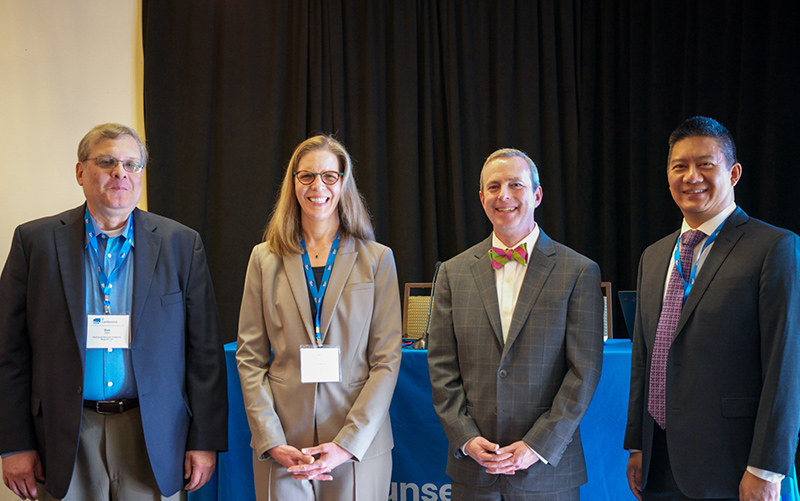When Peggy Lillis was put on an antibiotic to treat an abscess after a root canal, her family had no idea of what was to come.
What followed was a shockingly fast decline due to C. diff, or Clostridioides difficile, a bacterium that can cause diarrhea, colitis, and other symptoms. While C. diff can occur at any time, it often becomes a problem, ironically, when a patient is taking antibiotics for an infection. This is because, while antibiotics fight bacterial infections by killing bad germs, they can also kill good germs, opening the door for bacteria like C. diff to gain a dangerous foothold.
Because Lillis and her family assumed she only had a stomach flu, the C. diff was given ample time to take hold, making Lillis incredibly ill. She was hospitalized with dangerously low blood pressure, and ultimately, required surgery to remove her colon.
“The doctor told us that she was so ill he was afraid she wouldn’t survive surgery,” her family writes, “but that she would very likely die from sepsis without it.”
Shortly after the surgery, Lillis’ health took a turn for the worse, and she passed away. However, her memory lives on in the Peggy Lillis Foundation for C. diff Education and Advocacy (PLF), which raises awareness about the dangers of C. diff so other families do not have to go through what the Lillis family experienced.
The Biotechnology Innovation Organization (BIO) is working with PLF to raise awareness during November’s C. Diff Awareness Month.
Here are the top four things you need to know about C. diff to keep you and your family safe.
Learn about C. diff and the Peggy Lillis Foundation
1. C. diff is one of the most common healthcare-associated infections.
In many ways, C. diff is a dangerous infection hiding in plain sight, often going under-reported and under-diagnosed. While hospital-acquired C. diff infections have been on the decline due to federal and state incentives like antibiotic stewardship programs, community-acquired cases continue to rise, with dangerous and sometimes deadly results.

As Danielle, an Iowa woman, learned, a responsive healthcare team is key to beating C. diff before it becomes deadly. “It all started on a weekend in August of 2023 with what I can only describe as a constant need to use the bathroom and a tingling sensation throughout my entire body that felt like pins and needles,” she writes.
Her primary care physician prescribed her antibiotics after she tested positive for C. diff.
A week later, Danielle’s C. diff infection returned, landing her in the hospital with a spiked fever and worsening abdominal pain. However, the doctors at Danielle’s hospital sent her home, which ultimately forced her to go to a different hospital when her symptoms worsened. She was diagnosed for a second time with C. diff.
“I was so angry and devastated, I cried.”
Eventually, a GI nurse practitioner put Danielle on a different C. diff-oriented antibiotic, which her immune system had never had. After a couple of rounds and weeks of illness, Danielle finally beat C. diff beat—but her body was never the same.
2. C. diff kills more Americans each year than HIV.
Despite C. diff’s deadly risk, “only a third of us have heard of it,” writes PLF.
As BMC of Infectious Disease explains, C. diff affects “500,000 patients annually in the United States, of whom around 30,000 will die.” This is compared to the almost 20,000 deaths per year from HIV.

Kristi M. learned about C. diff the hard way. After a tooth abscess put her on a round of antibiotics, she assumed her symptoms were a side effect of the medication. But when her symptoms became acute, she knew something was wrong.
“That’s when I came across information about C. diff. It was my first time hearing about the infection,” she writes. Indeed, lack of awareness often results in delayed treatment as patients assume that their symptoms are a result of something else.
After her first round of treatment led to a return in C. diff, Kristi resolved to educate herself during her second, longer round of the antibiotic. “I took the infection seriously. I learned a lot by reading stories on a C. diff forum as well as my own personal research.”
After changing her diet and getting the care she needed quickly, Kristi has been clear of the infection. “I feel like myself again,” she writes. “It was scary, but knowledge is power.”
3. Antibiotic use is a common risk factor for C. diff infections.
“People who have recently taken antibiotics are at 7–10 times greater risk for contracting C. diff,” explains PLF.
This risk is heightened when patients take antibiotics unnecessarily. This is a lesson that A.J., a New Jersey woman (and self-proclaimed hypochondriac), will not soon forget.
“I had a sore throat and immediately I went to the doctor, who said it was not bacterial, so he didn’t give me an antibiotic,” she writes. “I called the office afterward and begged for an antibiotic, as I thought this was going to keep me safe.”

Reluctantly, A.J.’s doctor prescribed her the antibiotics she was insisting on and shortly after, she noticed an onset of symptoms during a camping trip: stomach cramps, diarrhea, etc. It wasn’t long until she was diagnosed with C. diff.
“I was so horrified and upset and sick. I was mad at myself for pushing for antibiotics and also mad that the doctor didn’t tell me no again.”
Though A.J.’s infection was ultimately cleared after intensive treatment, 17 years later, “I’m still deathly afraid of taking any medication or being around sick people,” she writes.
4. C. diff is costly.
As the PLF explains, “Between 1986 and 2013, C. diff was among the top 5 most expensive healthcare-associated infections in the US.”
“This results in an annual $5 billion cost to the economy,” writes the National Foundation for Infectious Disease, “with patients reporting spending an average of $4,355 in out-of-pocket costs on treatment.” This is not counting the prolonged cost of C. diff on the healthcare system that can see patients relapse or have long-term issues as a result of the infection.

Mira of Washington saw just how costly C. diff was after she acquired the infection during the COVID pandemic. Repeatedly told that her symptoms were “just COVID” or she was “just anxious,” Mira’s infection went on far longer than it should have, and she became very ill.
Two GI doctors later, she tested positive for C. diff, she explains. She started a C. diff antibiotic run but ended up in the hospital four days later with hemorrhagic diarrhea and a swollen colon.
“The hospitalist told me I was lucky to be alive. I honestly barely remember the stay, aside from being worried about getting COVID on top of C. diff,” she says.
She contracted C. diff three more times, with treatment options frequently delayed as a result of the pandemic. She was ultimately able to beat her infection as a result of a successful fecal microbiota transplantation.
Mira still deals with C. diff’s latent effects. “C. diff has damaged my colon, and I have extreme post-infectious colitis. As long as I stay clear of C. diff, it’s a small price to pay.”
For more information on C. diff and how to keep you and your family safe, visit cdiff.org.




